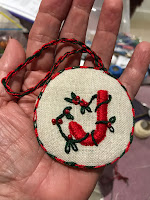The term 'sentinelle' relates to the English term 'sentry'. It is someone standing guard, watching over, guarding.
I began this one with the halo. Given the shapes in the screenprint, I looked to see if I had any round beads and found a couple of packs of heart shaped ones almost the exact size I was looking for.
Having done that I needed bugle beads for the outer edge.
From the beginning I had the notion of using shisha mirrors on the cloak. The circular motifs seemed to cry out for it.
I experimented with metallic thread to hold them in. Somewhat to my surprise, it worked quite well. It took a bit of time, and required working with a relatively short thread , but proved fun to do.
I worked the mirrors in first, then added the surrounding spokes and the lozenge beads.
Because I was, at the same time, obsessed with Colcha embroidery and Colcha/Bokhara stitch, I used the stitch for some of the embroidery on the cloak. It worked well for the long folds - stitched on the diagonal rather than the full length of the fold.
For much of it I used chain stitch. I also ran some gimp down the edges of the folds. This was quite hard to keep tight, no matter how hard I tried. I tightened it several times.
I also worked out colours as I went - working from a general notion of the effect I wanted.
The metallic mirror surrounds worked the same way - I used two metallics in dark blue and bluey-red.

I filled the background in using a black synthetic with silver - very easy to use and providing some texture along the lines of the print
I also used a very fine copper metallic to outline the facial features and more bugle beads on the head band.
Here"s the finished panel, being blocked, ready to be mounted in batik. The blue of the panel is truer here than in previous photos.

Once again, I'm delighted with the batik - from Crissy at Batik Fabric Online.
Again, I worked a border in one of the Kantha edges from The Art of Kantha Embroidery, by Niaz Zarman.
 Here she is, very crumpled, in all her splendour and, on the right, with continental pillow insert on Christmas Day.
Here she is, very crumpled, in all her splendour and, on the right, with continental pillow insert on Christmas Day.In the next couple of weeks I will post the other three guardian cushions.





























